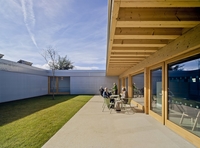Chester & Cheshire
- Home
- Add Listing
- Going Out
- -- Night Clubs
- -- Pubs & Bars
- -- Restaurants and Cafes
- -- Theatres and Cinema
- Pets
- Places to Stay
- Professional Services
- Services
- -- Business To Business
- -- Childrens
- -- Finance
- -- Hairdressers and Beauty Salons
- -- Health & Safety
- -- Property
- -- Tradesmen
- Shopping
- -- DIY
- -- Electrical Equipment
- -- Entertainment
- -- Fashions
- -- Galleries
- -- Home Improvements
- -- Motoring
- Things To Do
- -- Attractions
- -- Outdoor Activities
- -- Sports
- Retail Therapy
- Chester Tourist Guide
- -- Chester Zoo
- -- Chester Cathedral
- Links
- Blog
Quick Search
 The areas or places we inhabit on a regular basis, this could be our homes or places of work - can have a very strong effect on our mood, feelings, thoughts and even on our behaviour. This is a concept that is well documented by psychologists and architects alike - certain architectural designs seem to bring out alertness and can help to maintain higher thought. Studies have shown that large rooms with high ceilings can help to foster creativity and inspiration, whereas rooms which have lower ceilings can help the individual to better focus at the task at hand. In the same way our built environment can have an effect on our well-being and how we perform, so can the interior design and the room arrangement. North Wales Interior Designer knows all about creating spaces which can promote healthy moods. Promoting Nature & Relaxation Traditionally, having views of natural landscapes such as meadows, parkland or beaches from the workplace were seen as being distracting - this was due to the belief that workers would get distracted and might be tempted to spend their time gazing at the pleasant scenery rather than completing the task at hand. However, we now know that the opposite is true; it has been recognised that this kind of scenery has been associated with higher productivity and a marked improvement in focus. On the other hand, busy urban street scenes with moving vehicles, people and numerous buildings are now considered to be distracting and can even be quite tiring as they require more cognitive power to process them in the brain. These principles can be applied to interior design - as a cluttered house doesn’t promote feelings of relaxation, as there are far too many items for the eye to focus on, too much information for the brain to process - which ends in an unrelaxing experience, conveying feelings of disorganisation and chaos. Health & Well-Being When you come home to an interior which makes you feel good and promotes positive feelings, it is ultimately going to be good for our general health and well-being - our thoughts and feelings are easily influenced by our surroundings. Even though many of us choose to decorate our homes using our favourite colours, unfortunately this doesn’t always guarantee a successful end result. It is important to create a balanced environment, and to consider the best way to effectively use the available space and choose a harmonious colour scheme which is both pleasant and relaxing for extended periods of time. Furniture This should be chosen with care, in order to bring out the best of your available space and to reflect your personal style and taste. Furniture and accessories are also used to convey the homeowners’ cultural heritage and background. Your sofa, chairs and the dining table can have a huge impact on the overall feel of your living space, and should be considered carefully. Many homeowners opt for soft forms and curved edges rather than having lots of sharp corners. Some studies conducted have hinted that this might be due to our subconscious mind alerting us to the danger, as sharp edges can be perceived as a potential threat. Colour Colour has an inconceivable amount of influence over our mood - and any successful hotelier or restauranteur will testify to this. Colour schemes and seating arrangements can be used to subtly encourage people to stay and relax in a specific area by using soft colours, comfortable seating and ambient lighting. Harsh lighting, bright colours and hard chairs can have the complete opposite effect and actually communicate that the area is only a temporary place to wait in. Seating Arrangements & Lighting Your chosen furniture arrangement can also have an impact on how much or how little people want to interact in your home. Positioning your seating against the wall discourages people from socialising, but positioning chairs in groups facing one another encourages interaction. Lighting choices can also have an influence on our moods - for example, low level dim lighting at a dinner party will stimulate conversation as your guests will feel more relaxed and willing to speak openly. In contrast, harsh overhead lighting will have the opposite desired effect. Natural lighting is important throughout our homes; sunlight and brightly lit environments have shown an increase in productivity - this is true in educational settings. A lack of natural light can lead to having low moods, and creating a depressive atmosphere in both the workplace and at home. |
Archives
March 2023
July 2022
May 2022
April 2022
October 2021
August 2021
April 2021
March 2021
November 2020
October 2020
September 2020
August 2020
July 2020
June 2020
May 2020
April 2020
March 2020
February 2020
January 2020
September 2019
July 2019
June 2019
April 2018
January 2018
December 2017
November 2017
July 2017
April 2017
April 2016
March 2016
January 2016
December 2015
October 2015
August 2015
May 2015
January 2015
September 2014
July 2014
November 2013
July 2013
November 2012
Other Sites In The "North West and Wales" Network
North Wales Online Community
Nursing Homes North West and Wales
Accountants North Wales & North West
